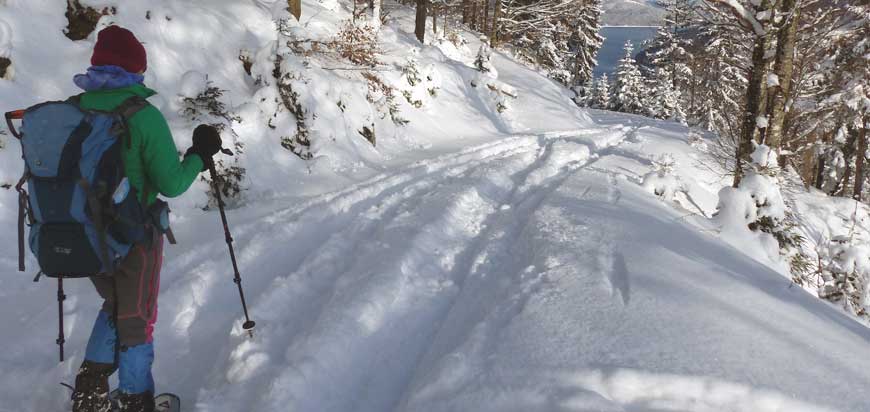Winter transforms the Bavarian Alps into a mesmerizing, fairy-tale-like wonderland. For those yearning to immerse themselves in the serene beauty of winter and escape the bustling ski slopes, snowshoeing and winter walking offer a perfect escape. Not only is the technique easy to learn, but you also have the flexibility to tailor your excursions to your preferred level of challenge. More than just a mode of transportation, snowshoeing provides a calming journey through nature, allowing you to savour the beauty and tranquility of the winter landscape.
To support your winter exploration, we've put together top tips to kickstart your journey, ensuring your safety and enjoyment. Additionally, we've crafted a convenient winter walking checklist for you to download.
Footwear
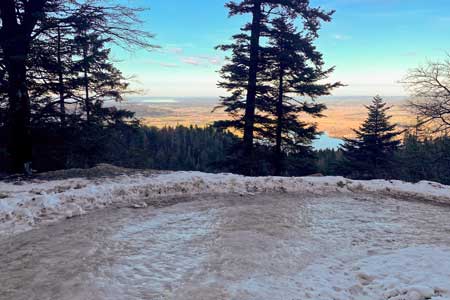
Icy Routes and Winter Walking
For seasons with less snow but plenty of ice, investing in spikes for your hiking boots is essential. These spikes provide secure footing on hard-packed surfaces, especially on north-facing slopes. Trekking poles add stability and are invaluable in such conditions.
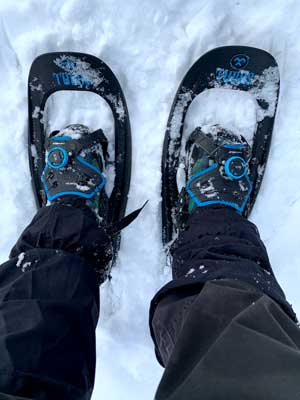
Magical Travel with Snowshoes
Once the snow has blanketed the terrain, snowshoes become your magical ticket to traverse this winter wonderland. Originally designed resembling tennis racquets, modern snowshoes are lightweight, offering flexibility and grip for diverse terrains. Similar to skis, there's a range of designs to suit various adventures. Learn about different types of snowshoes during our Guided Snowshoe tours this winter. You can rent snowshoes at local sports stores or at the German Alpine Club (www.alpenverein.de). Don't forget your trekking poles, easily adaptable for winter with the switch to snow baskets.
Ensuring Comfort and Stability
Stable footing is crucial, but ensuring your comfort is equally important. Opt for waterproof hiking boots with full ankle support and warm, thicker woollen socks. Gaiters are a key ingredient, preventing snow from slipping into your boots and maintaining that warm, happy place.
Tour planning
Winter walking or snowshoeing adventure requires minimal skills. Basic ascent and descent techniques form the foundation, but understanding your impact on the winter environment and the risk of avalanches is crucial. Selecting routes that minimise impact on nature, especially in marked trails within ski resort areas, is a great starting point. For off-the-beaten-track exploration, consider professionally led courses to build skills and awareness. If delving into backcountry, invest in avalanche gear and proper training.
You always have to start somewhere, so do not be put off if you have no experience- start building knowledge gradually- go with professionals as they will know where to find the best snow, most appropriate trails and conditions and will be able to support you with your technique in different snow and terrain. Then build up experience by going with more experienced friends, study and discuss avalanche reports, conditions, snow pack etc. and together explore the fascinating topic of snow – it’s addictive!
Look after yourself
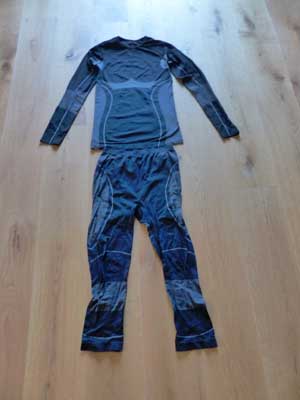
Clothing
One of the biggest errors in winter walking and snowshoeing is dressing like a Michelin man in the expectation that you are going to freeze! Just like all other mountain sports- it’s about the layers. Walking uphill in snow will generate considerable warmth and will soon be shedding the layers. A good moisture-wicking base layer is the key – both tops and bottoms (think ski underwear). Then a lightweight fleece, insulated layer (e.g. primaloft/ down jacket) and hardshell (waterproof and wind proof). A change of base layer (long sleeved top) is essential for switching out when you reach a summit and will keep you warm as you cool down on the descent.
Check out our ultimate guide to dressing for winter to learn the essentials for dressing for comfort and joy on the mountain in winter.
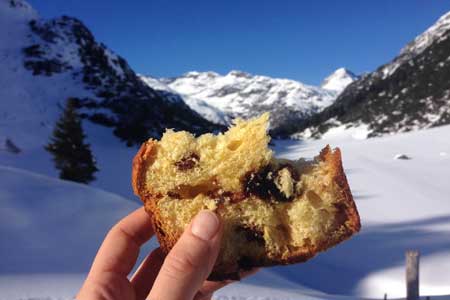
Food & Drink
Snowshoeing is a big calorie burner- so you need to keep yourself well-nourished along the way. Plenty of little snacks – nuts, chocolate, peanut butter and jam sandwiches, eggs. Additionally, through the sweating and cold air we also lose a lot of moisture, so keeping well-hydrated along the way is essential. Pro-tip: bring a thermos of hot tea with a drop of honey.
Exploring low impact
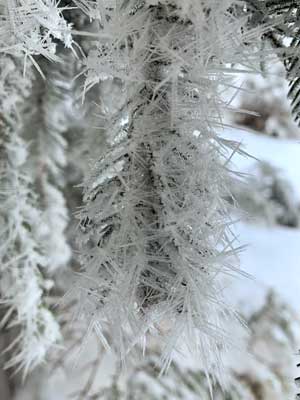
During wintertime if we are not careful we might invade the living room of an animal who is in winter survival mode- costing it precious energy either in fleeing or disrupting its source of food and nourishment. There are a few easy principles that we can apply to do our best to avoid this:
- Get map-reading and understand where protected areas are on the map.
- Avoid summits ridges and low-shrub zones (home to black grouse- Birkhuhn) between 4pm and 10am .
- In forests keep to routes recommended by organisations such as DAV when passing through woodland to minimise disruption.
- Be aware of the terrain and avoid areas of reforestation or treading on saplings.
- As always leave no trace – from apple cores, to toilet paper- everything we carry in, we carry out.
Hopefully this information is useful to get you started and get out there this winter!
